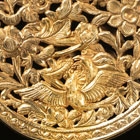J.J. Lally & Co., Oriental Art / New York City, New York
MenuPast Exhibition
Chinese Porcelain and Silver in the Song Dynasty
March 18 - April 8, 2002
35.
A CHASED GOLD OPENWORK PENDANT (XIANG NANG)
Song Dynasty (A.D. 960-1279)
of teardrop shape, made in two pieces decorated with mirror-image renditions of the same design, each side showing two pairs of songbirds flying amidst dense foliage and flowers, all in openwork and varied relief with finely chased and stamped details throughout, within a narrow ropetwist border enclosed by a wide zig-zag band of raised petal motifs, surmounted by a trefoil scrollwork cresting pierced with a wide aperture for suspension, with flanged edges all around, one half very slightly smaller and fitting snugly inside the other half, leaving space for sandalwood or another fragrant material to be inserted between the two halves, the surface showing some discoloration and with traces of earth from burial.
Length 3 1⁄2 inches (8.9 cm)
An openwork gold pendant of similar form decorated with phoenix in floral scroll, discovered in 1980 in a Northern Song tomb in Nanjing, Jiangsu Province, is illustrated in the excavation report in Wenwu, 1982, No. 3, pl. 3 and is illustrated again in Zhongguo Meishu Quanji (The Great Treasury of Chinese Fine Arts), Vol. 10: Gongyi Meishu Bian (Works of Art and Craft), Beijing, 1987, Vol. 10, p. 41, col. pls. 86 and 87, with full description on p. 25, where it is reported that the pendant was found suspended from a silk cord around the neck of a woman in the tomb together with many other gold and silver ornaments.
Another openwork gold pendant of closely related form, decorated on each half with a pair of phoenix amidst flowers and foliage is illustrated in the catalogue of the exhibition shown at the Rietberg Museum entitled Chinesisches Gold und Silber: Die Sammlung Pierre Uldry, Zurich, 1994, no. 288.
Compare also the Song dynasty gold openwork pendant of similar shape and technique but decorated with confronted dragons, illustrated in Adornment for the Body and Soul- Ancient Chinese Ornaments from the Mengdiexuan Collection, Hong Kong, 1999, p. 289, no. 131.
